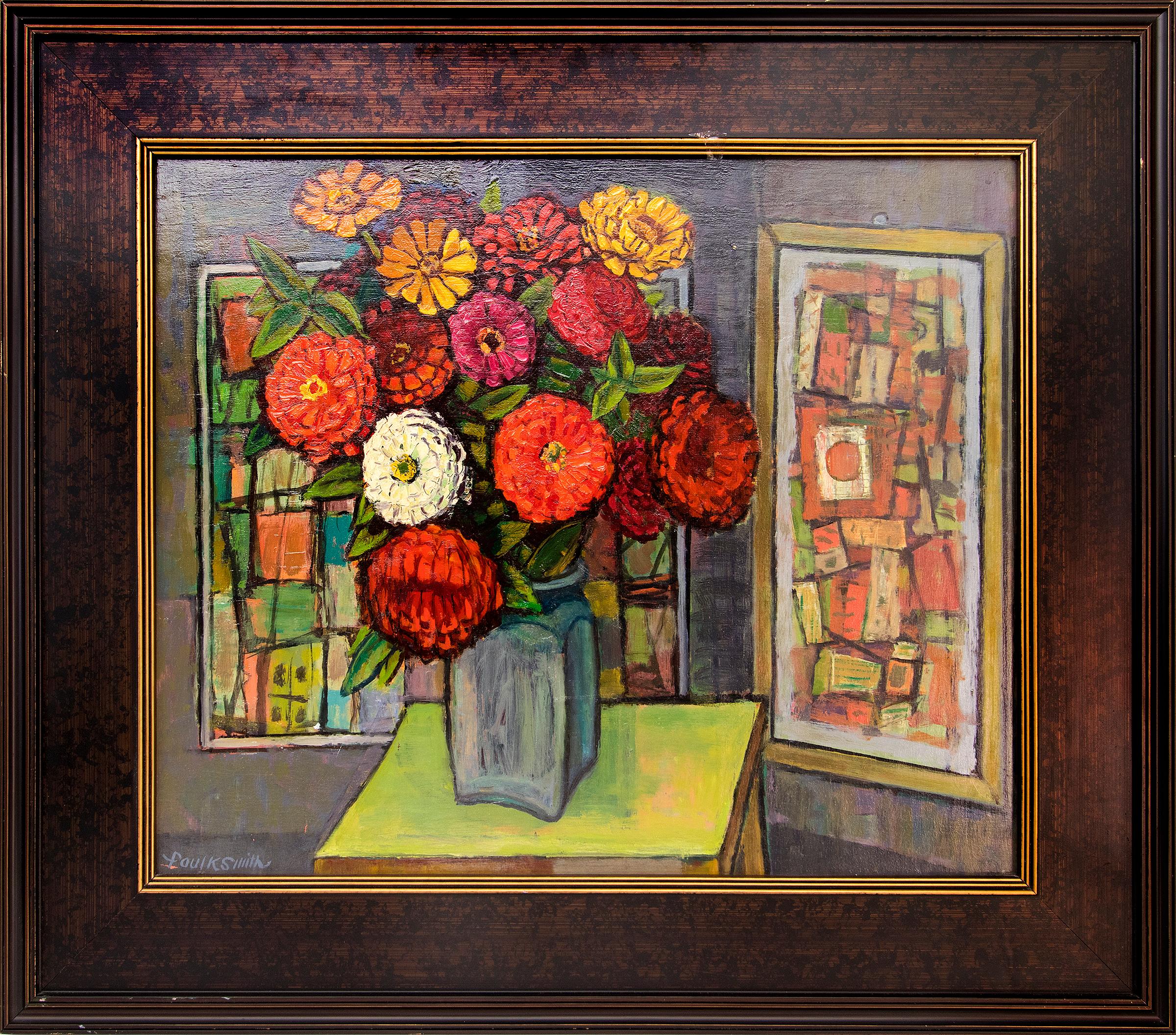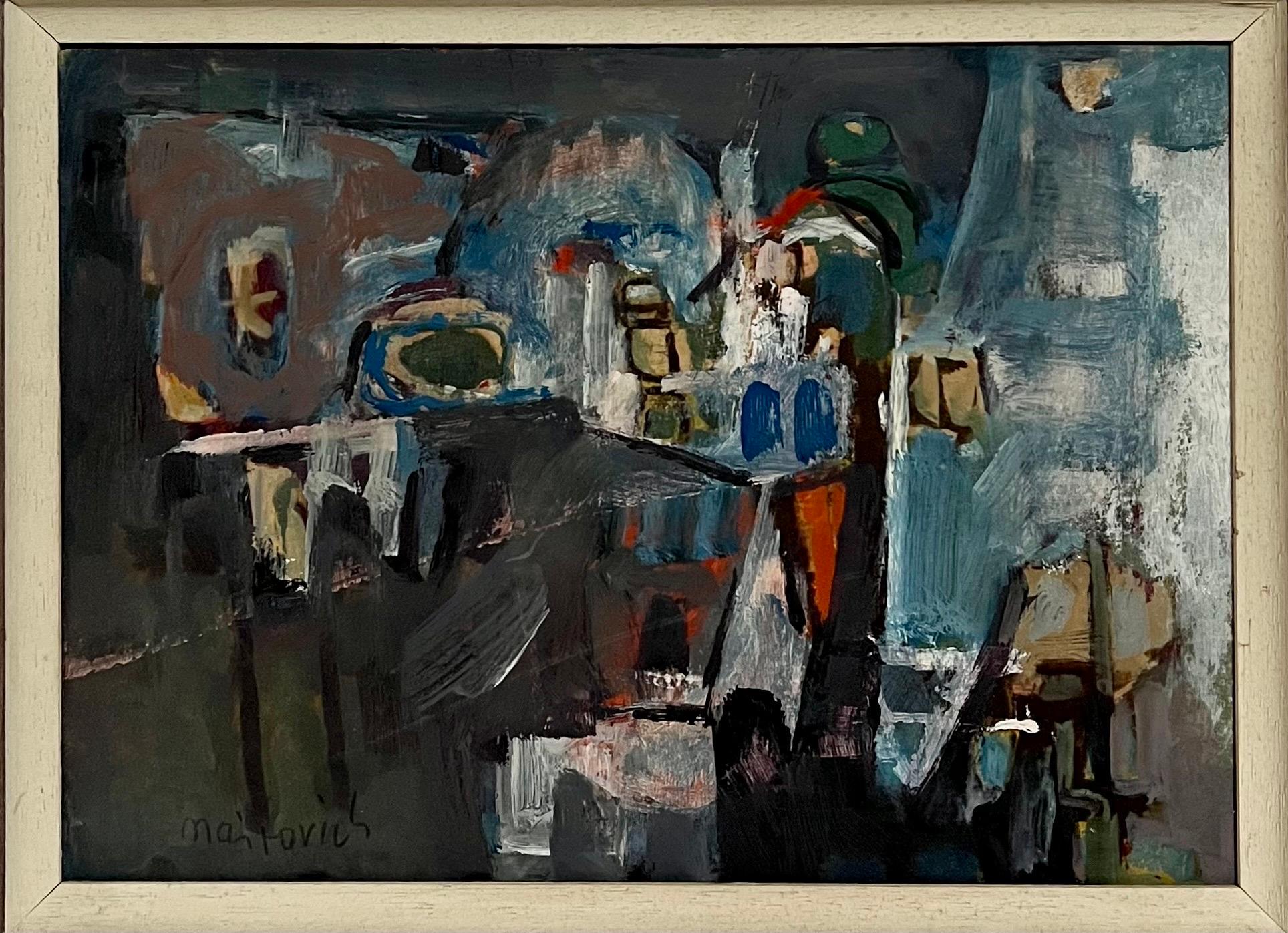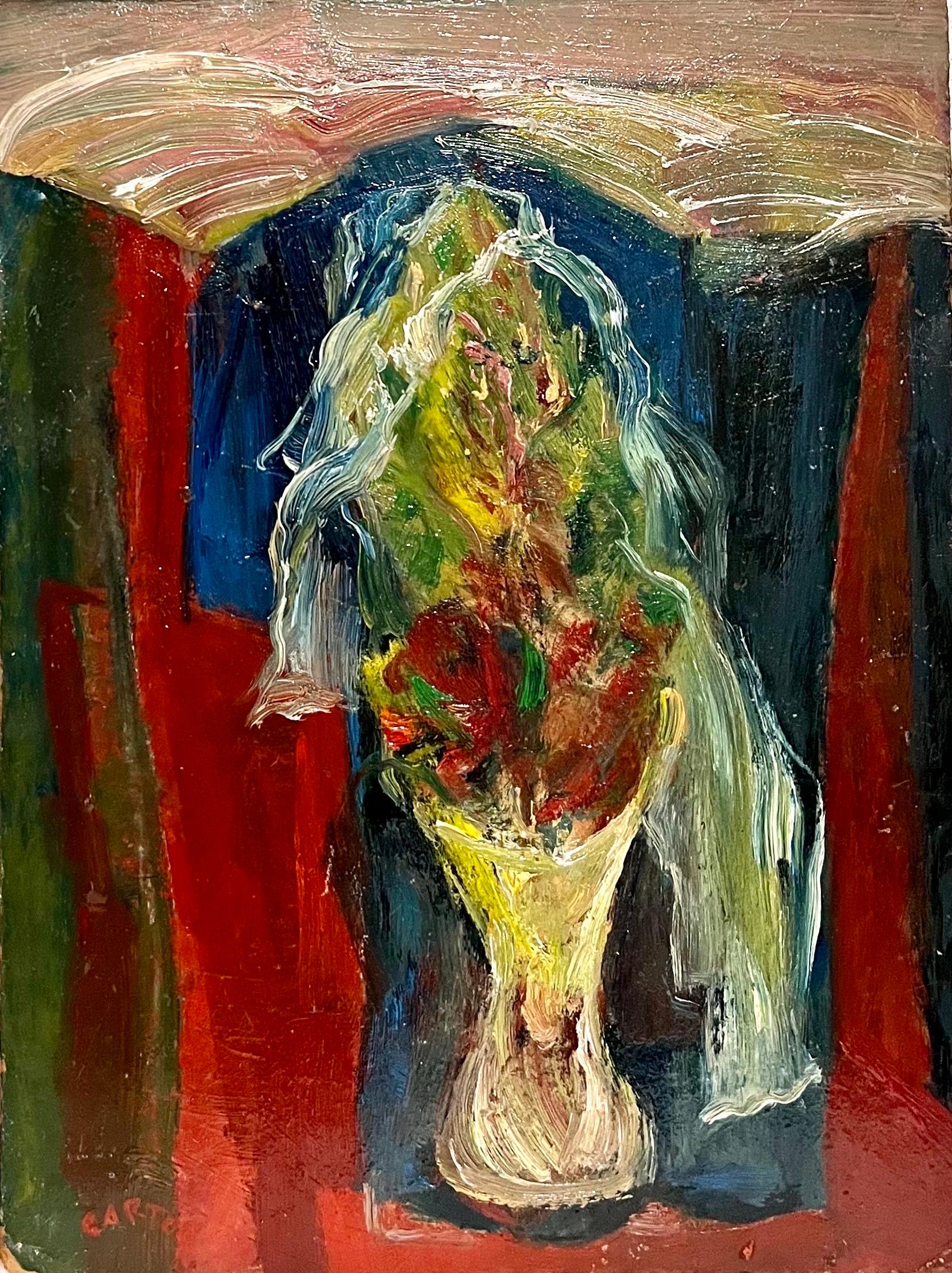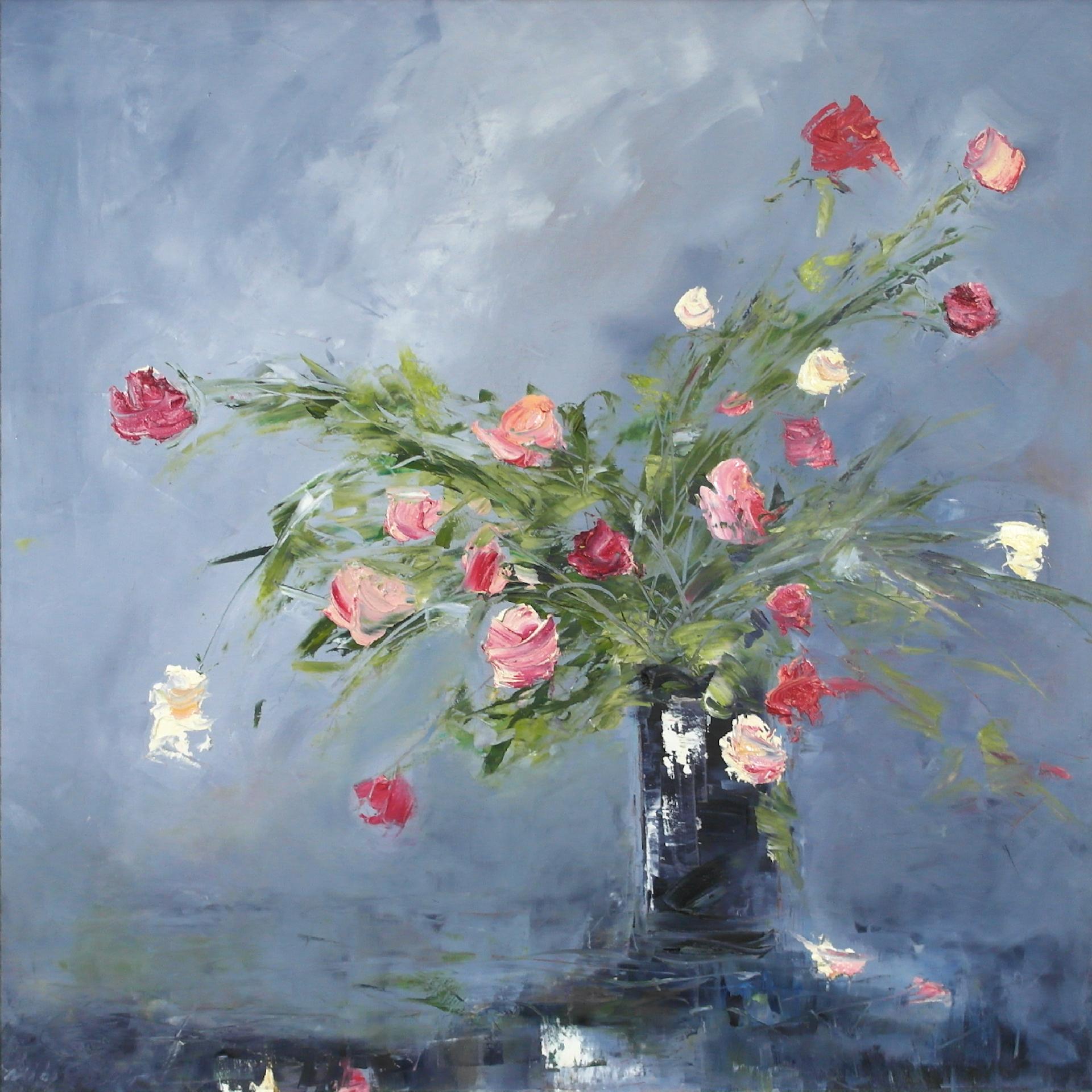Items Similar to Still Life with Fruit
Want more images or videos?
Request additional images or videos from the seller
1 of 21
Juliane SolignacStill Life with Fruit1968
1968
About the Item
'Still Life with Fruit', oil on board (1968), by Juliane Solignac. An engaging yet unusual artwork with vibrant colours, thickly applied with a painting knife. Nonetheless, through the thick paint there is an unfinished quality to the work leaving the impression that the raw canvas - or board in this case - is revealed. Some of the colour seems to have been scored on to the work with an artist's knife leaving lines and creating angles as in a cubist painting. There are layers of paint with no evident brush strokes. One may believe in this instance, Madame Solignac used this technique to create a visual effect which would deliberately have upset traditionalists. Be reminded that the Impressionists were criticised for creating patchy, incomplete works because there were strong notions about the correct way to paint in those days. Picasso once said, 'To finish a work is to kill it.' It is unsure how Mme Solignac would have felt about that. Regardless of this conjecture, the painting is colourful, compelling and rewards the viewer with a curious interest. The work is in fair vintage condition, newly framed with a linen slip. It is signed: 'Julian Solignac 68'.
About the Artist: Juliane Solignac (born 1904). Regrettably, there is not much information available about the artist (including what year she may have died). She is referenced as a resident artist in Montmartre in the 1930s, one of only a handful of women in an otherwise sea of male names. In addition, Solignac is mentioned in both French and Dutch references as a creator of fabrics. These may have been more artistic 'tapis' which are hung on the wall like a painting. A Dutch museum references having one of her designs in their collection. Here is a quote from the magazine, 'COTE', Edition Nº 9 (March 2009): "Until 20 April, Pierre Frey is exhibiting 50 printed fabric works from their own collection dating from 1936 to today. Most were produced in liaison with artists like Jean Chatanay, Irène Rohr, Juliane Solignac, Rieffel Anossof, Janine Janet and Jean- Denis Malclès."
Dimensions with frame:
H 39 cm / 15.4"
W 51 cm / 20.1"
Dimensions without frame:
H 25.5 cm / 10.0"
W 37.5 cm / 14.8"
- Creator:Juliane Solignac (1904)
- Creation Year:1968
- Dimensions:Height: 15.36 in (39 cm)Width: 20.08 in (51 cm)
- Medium:
- Movement & Style:
- Period:
- Condition:
- Gallery Location:London, GB
- Reference Number:
About the Seller
5.0
Platinum Seller
These expertly vetted sellers are 1stDibs' most experienced sellers and are rated highest by our customers.
Established in 2016
1stDibs seller since 2017
439 sales on 1stDibs
Typical response time: <1 hour
- ShippingRetrieving quote...Ships From: London, United Kingdom
- Return PolicyA return for this item may be initiated within 7 days of delivery.
More From This SellerView All
- 'Cubist Still Life', School of BerlinLocated in London, GB'Cubist Still Life', oil on board, with guitar, wine bottle and glasses, (circa 1950s - 1960s), by an unknown artist. A masterly cubist still life representation depicting items atop...Category
1950s Abstract Abstract Paintings
MaterialsOil, Board
- 'Still Life with Fruit', Berlin SchoolLocated in London, GB'Still Life with Fruit', oil on board, by an artist with initials 'T.N.', from Berlin School (circa 1960s). A stunning, conceptual composition depicting a bowl with fruit on a table. The backdrop horizontal paint...Category
1960s Modern Still-life Paintings
MaterialsOil, Board
- 'Symphony of Colour: Cubist Still Life with Guitar and Wine', Berlin SchoolLocated in London, GB'Symphony of Colour: Cubist Still Life with Guitar and Wine', oil on board, Berlin School, initialed 'M.V.' (circa 1960s). This artwork is a clear cubist homage to one of the founder...Category
1960s Cubist Still-life Paintings
MaterialsOil, Board
- Still Life on Black BackgroundBy Edgar StoëbelLocated in London, GB'Still Life on Black Background, oil on canvas (circa 1960s), by Edgar Stoëbel (1909-2001). In his inimitable style, artist Stoëbel's abstract still life with black background is a lively and colourful modernist work. This artwork has a powerful intensity of tone and colour which speaks to Stoëbel's very distinctive style but remains completely approachable and appealing. This is part of the post-war concrete abstract movement, or Constructive Art...Category
1960s Constructivist Abstract Paintings
MaterialsCanvas, Oil
- Floral BouquetLocated in London, GB'Floral Bouquet', oil on panel, by Italian artist, Alvaro Danti (circa 1960s). An Asian-inspired still life with carnation flowers and a branch of cherr...Category
1960s Modern Still-life Paintings
MaterialsOil, Board
- Still Life with PineappleBy Lucien MartialLocated in London, GB'Still Life with Pineapple', oil on panel, by Lucien Martial (circa 1960s). Like human life, fruit is perishable and ephemeral, and thus many believe th...Category
1960s Expressionist Still-life Paintings
MaterialsBoard, Oil
You May Also Like
- American Modernist Abstract Still Life Painting with Zinnia Flowers, Red OrangeLocated in Denver, COOil on board painting by Paul Kauvar Smith (1893-1977) of a still life of flowers on a table in an interior scene with a mirror in the background. American Modernist still life painting with zinnias and abstract paintings in an artists studio. Presented framed, outer dimensions measure 27 ⅝ x 31 ¾ x 1 ⅛ inches. Image size is 19 ½ x 23 ½ inches. Painting is clean and in very good vintage condition - please contact us for a detailed condition report. Provenance: Private collection, Denver, Colorado Expedited and international shipping is available - please contact us for a quote. About the Artist: In 1915, Paul Kauver Smith studied commercial art and design at the St. Louis School of Fine Art for two years. His studies were interrupted by World War I during which he served as a corporal in the U.S. Army. After the war he returned to the School of Fine Art and also studied at the Washington University School of Fine Arts in St. Louis with Fred G. Carpenter, himself a student of Jean-Paul Laurens at the Colarossi Academy in Paris. Carpenter was known as a marvelous colorist who "thought every inch of a painting should be fascinating…and should be as interesting close up as from a distance." His approach is reflected in many of Smith’s paintings, both representational and abstract in style, done later in Colorado. In 1921, Smith relocated to Denver where he studied for two years at the Denver Academy of Fine and Applied Arts, formerly located in Brinton Terrace on 18th Street in Denver’s Capitol Hill neighborhood. His teacher was John E. Thompson, another important influence as a pioneer of modernism in Denver. The Academy hired Smith as an instructor in 1923 and that same year the Denver Art Museum included his work for the first time in its 29th annual juried exhibition. He later had two solo shows at the museum, which added his work to its Anne Evans Collection. In 1959 the museum reproduced Houses at Victor, for its Western Heritage Exhibition catalog. During the year of 1928 he witnessed the Articles of Incorporation of the Denver Artists Guild, comprising most of the city’s professional artists. He also belonged to the American Artists Professional League, also organized in 1928 by fifteen members of the Salmagundi Club in New York to protect artists’ interest and promote traditional American art. He was one of some two dozen Colorado artists designated to participate in the Public Works of Art Program (PWAP, 1933-34), the first federally-sponsored program for artists during the Great Depression. Around 1928 Smith became the "Hermit of Stuart Street," and remained a life-long bachelor. One painting, View from My Window, depicts his immediate neighborhood. Living for more than thirty years at 1039 Stuart Street in West Denver, he gave up creature comforts that most people take for granted to have the freedom to devote his life to the pursuit of art. In the first twenty-five years of his career, his paintings focused on the Colorado landscape and its mining towns with their decaying buildings as relics of the past. His piece, Miner’s House at Victor, Colorado illustrates the description of his work in this genre as described by Denver artist and art writer, Arneill Downs, "The jewel-like shapes and colors the artist uses gives the most decrepit objects style. The decaying buildings of ghost towns, grouped together on canvas, glow like a patchwork quilt." Smith described his technique as "I start lean and finish fat." He worked first with turpentine as a medium and ended up with pure pigment put on with a palette knife. In addition to Colorado scenes...Category
20th Century Abstract Still-life Paintings
MaterialsOil, Board
- Polish Israeli Abstract Vibrant Cityscape Tel Aviv Modernist Painting MairovichBy Zvi MairovichLocated in Surfside, FLBold, colorful abstract cityscape of Tel Aviv 15 X 19 inches including mat (needs new mat). painting is 10.5 X 14.5 Provenance: prominent South Florida art...Category
20th Century Abstract Abstract Paintings
MaterialsOil, Gouache, Board
- American Abstract Expressionist Flowers Oil Painting Norman Carton WPA ArtistBy Norman CartonLocated in Surfside, FLNorman Carton (1908 – 1980) was an American artist and educator known for abstract expressionist art. He was born in the Ukraine region of Imperial Russia and moved to the United States in 1922 where he spent most of his adult life. A classically trained portrait and landscape artist, Carton also worked as a drafter, newspaper illustrator, muralist, theater set designer, photographer, and fabric designer and spent most of his mature life as an art educator. Carton showed in and continues to be shown in many solo and group exhibitions. His work is included in numerous museums and private collections throughout the world. Norman Carton was born in the Dnieper Ukraine territory of the Russian Empire in 1908. Escaping the turbulence of civil war massacres, he settled in Philadelphia in 1922 after years of constant flight. While attending the Pennsylvania Museum School of Industrial Art, Carton worked as a newspaper artist for the Philadelphia Record from 1928 to 1930 in the company of other illustrator/artists who had founded the Ashcan School, the beginnings of modern American art. From 1930 to 1935, he studied at the Pennsylvania Academy of Fine Arts under Henry McCarter, who was a pupil of Toulouse-Lautrec, Puvis de Chavanne, and Thomas Eakins. Arthur Carles, especially with his sense of color, and the architect John Harbison also provided tutelage and inspiration. Following his time at the Pennsylvania Academy of Fine Arts, Carton studied at the Barnes Foundation from 1935 to 1936 where he was influenced by an intellectual climate led by visiting lecturers John Dewey and Bertrand Russell as well as daily access to Albert C. Barnes and his art collection. Carton was awarded the Cresson Traveling Scholarship in 1934 which allowed him to travel through Europe and study in Paris. There he expanded his artistic horizons with influences stemming from Henri Matisse, Pablo Picasso, Chaim Soutine, and Wassily Kandinsky. While at the Pennsylvania Academy of Fine Arts, Carton was also awarded the Toppan Prize for figure painting as well as the Thouron Composition Prize. He received numerous commissions as a portrait artist, social realist, sculptor, and theatrical stage designer as well as academic scholarships. During this time, Carton worked as a scenery designer at Sparks Scenic Studios, a drafter at the Philadelphia Enameling Works, and a fine art lithographer. From 1939 to 1942, the Works Progress Administration (WPA) Federal Art Project employed Carton as a muralist and easel artist. He collaborated with architect George Howe. The WPA commissioned Carton to paint major murals at the Helen Fleischer Vocational School for Girls in Philadelphia, the Officers’ Club at Camp Meade Army Base in Maryland, and in the city of Hidalgo, Mexico. Throughout the 1940s, Carton exhibited and won prizes for his semi-abstract Expressionist and Surrealist paintings. He socialized with and was inspired by Émile Gauguin and Fernand Leger. During World War II, Carton was a naval structural designer and draftsman at the Cramps...Category
Mid-20th Century Abstract Expressionist Still-life Paintings
MaterialsOil, Board
- Abstract Expressionist Floral ExplosionBy Allie William SkeltonLocated in Soquel, CABright and expressive abstract painting of flowers by Allie Bill Skelton (American, 1942-1986). This piece is unsigned, but was acquired with a collection of other Allie "Bill" Skelton works. Unframed. Image, 12”H x 9”W, oil on artists canvas board. Allie William “Bill” Skelton (American, 1942-1986) was a painter and sculptor active in San Francisco who was involved in the gay art...Category
1980s Abstract Expressionist Abstract Paintings
MaterialsCanvas, Oil, Cardboard
- Rosie Copeland, Lilies and Rose Buds, Original Semi Abstract Floral PaintingBy Rosie CopelandLocated in Deddington, GBLilies and Rose bud by Rosie Copeland [2019] Original Oil on board Image size: H:37 cm x W:24 cm Complete Size of Unframed Work: H:2 cm x W:37 cm x D:24cm Framed Size: H:55.5 cm x W:...Category
21st Century and Contemporary Abstract Impressionist Still-life Paintings
MaterialsOil, Board
- Black Jar and Roses, Libbi Gooch, Semi-Abstract Painting, Contemporary ArtworkBy Libbi GoochLocated in Deddington, GBLibbi Gooch Black Jar and Roses Original Abstract Still Life Painting Oil on Board Canvas Size: 80 cm x 80 cm x .5 cm Framed Size: 93 cm x 93 cm x 1.8 cm Sold Framed Free Shipping Pl...Category
21st Century and Contemporary Abstract Impressionist Still-life Paintings
MaterialsOil, Board
Recently Viewed
View AllMore Ways To Browse
Vintage Fruit
Sea Life Prints
Still Life With Picasso
Vintage Fruit Signs
Sea Life Wall Art
Sea Life Prints Vintage
Still Life Fruit Print
Abstract Fruit Print
Vintage Fruit Wall Art
Fruit Knife
Vintage Dior Magazine Print
W Coter
Tapis Artist
Vintage Fruit Print
Score Board
Scoring Board
Picasso Male
Vintage Janine





